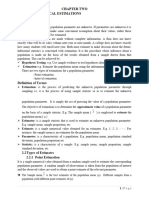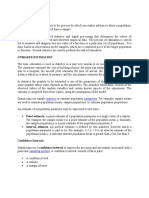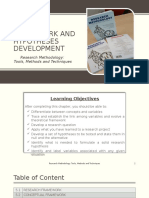0 ratings0% found this document useful (0 votes)
13 viewsModule 05 Estimation of Parameters
Uploaded by
glenn.apon24Copyright
© © All Rights Reserved
Available Formats
Download as PDF, TXT or read online on Scribd
0 ratings0% found this document useful (0 votes)
13 viewsModule 05 Estimation of Parameters
Uploaded by
glenn.apon24Copyright
© © All Rights Reserved
Available Formats
Download as PDF, TXT or read online on Scribd
You are on page 1/ 3
Module 5 Estimation of Parameters
Problems concerning the estimation of parametrical values are basic to
educators, scientists, engineers, and businessmen. A n error in estimation would
lead to biased results, and as a consequence, biased decisions as well. Thus, the
study of the estimation of parameters plays an important role in any area of
discipline. Let us say a manager is researching on the problems regarding the daily
outputs of his 2,000 workers. It would be too costly and time-consuming to study
the entire population of 2,000. Instead, focusing on a sample of 50 to 100
selected employees to determine their average output greatly simplifies the
problem. This called a point estimate. The study of the output of a group of
workers by intervals is an example of an interval estimate of a parameter.
Proper estimation of population parameters results in accurate data and
quick solutions to real-life problems in any field of study.
Key Words :
Estimation – the process of making inferences about a population based
on information obtained from the sample.
Point estimate – the sample mean x̄ of the population or mean µ . It is the
numerical value which gives an estimate of a parameter.
Interval estimate – a range of values used to estimate the parameter. It can
be calculated using two numbers or values which may or may
not contain the value of the parameter being estimated.
Statistics – measurement or observations from a sample population. This is
usually denoted by Arabic letters (e.g. x.̄ = average, sd = standard
deviation, p=proportion)
Parameters – measurement from the universe or target population. This is
usually unknown and differentiated from statistics by Greek
Letters (e.g. µ=population mean, σ = standard deviation,
π=proportion)
Two Types of Making Inferences About the Population
1. Estimation
Estimation uses a sample statistic to approximate the unknown
population parameter. A point estimate is the best estimate, in some
sense, of the parameter based on a sample. It should be obvious that any
point estimate is not absolutely accurate. It is an estimate based on only a
single random sample. If repeated random samples were taken from the
population, the point estimate would be expected to vary from sample to
sample. Interval estimate on the other hand consists of two numbers, an
upper and a lower limit – these are used to serve as the bounding values
within which the population parameter is expected to lie with a certain
degree of confidence. Interval estimation is important in statistical
inference, as it important in statistical inference, as it takes into account
the sampling error and helps in making the results more precise.
Confidence Intervals
General Formula:
95% Confidence Interval = Point estimate ±
(Reliability coefficient x Standard error )
Reliability Coefficients – These are taken from the table of
probabilities (e.g. T-table, Z-table, chi square table). They are dependent on
the given confidence level. As confidence level increases, the reliability
coefficient also increases.
Confidence Reliability Coefficient (Z
Level value)
90% 1.64
95% 1.96
99% 2.58
Point Estimates and Standard Errors
Standard errors are a function of the measure of variation and
sample size
Point Estimate Standard Error
Sample proportion Std. error =
(p)
Sample mean ('x̄' ) Std error
Where : p = proportion; n = sample size; sd=standard deviation
You might also like
- Week 2 Homework - Summer 2020: Attempt HistoryNo ratings yetWeek 2 Homework - Summer 2020: Attempt History27 pages
- CHAPTER 9 Estimation and Confidence Intervals100% (1)CHAPTER 9 Estimation and Confidence Intervals45 pages
- Estimation and Sample Size DeterminationNo ratings yetEstimation and Sample Size Determination37 pages
- Materi 4 Estimasi Titik Dan Interval-EditNo ratings yetMateri 4 Estimasi Titik Dan Interval-Edit73 pages
- Statistics and Probability Module 4 MoodleNo ratings yetStatistics and Probability Module 4 Moodle6 pages
- 1 Review of Basic Concepts - Interval EstimationNo ratings yet1 Review of Basic Concepts - Interval Estimation4 pages
- University of Gondar College of Medicine and Health Science Department of Epidemiology and BiostatisticsNo ratings yetUniversity of Gondar College of Medicine and Health Science Department of Epidemiology and Biostatistics119 pages
- Chapter 8 Estimation & Hypothesis Testing Copy Copy1No ratings yetChapter 8 Estimation & Hypothesis Testing Copy Copy111 pages
- Ch 2-Confidence Interval and Sample Size -YARANo ratings yetCh 2-Confidence Interval and Sample Size -YARA27 pages
- Point and Interval Estimation: Presented By: Shubham Mehta 0019100% (1)Point and Interval Estimation: Presented By: Shubham Mehta 001943 pages
- Unit-4-Estimation-and-Hypothesis-testing RevisedNo ratings yetUnit-4-Estimation-and-Hypothesis-testing Revised34 pages
- FIN 640 - Lecture Notes 4 - Sampling and Estimation100% (1)FIN 640 - Lecture Notes 4 - Sampling and Estimation40 pages
- Lecture 5 final Point Estimation and Interval EstimationNo ratings yetLecture 5 final Point Estimation and Interval Estimation10 pages
- Estimation of Population Parameters: 1) Estimating The Population MeanNo ratings yetEstimation of Population Parameters: 1) Estimating The Population Mean19 pages
- Overview Of Bayesian Approach To Statistical Methods: SoftwareFrom EverandOverview Of Bayesian Approach To Statistical Methods: SoftwareNo ratings yet
- Graduate Econometrics Lecture Notes - Michael Creel (414 Pages)100% (1)Graduate Econometrics Lecture Notes - Michael Creel (414 Pages)414 pages
- Business Research Methods Page1 Question BankNo ratings yetBusiness Research Methods Page1 Question Bank20 pages
- Uji Reliabilitas Dan Daya Diskriminasi AitemNo ratings yetUji Reliabilitas Dan Daya Diskriminasi Aitem5 pages
- Ghana Christian International High SchoolNo ratings yetGhana Christian International High School3 pages
- 3 - Stat - More Graphs and Displays 2024No ratings yet3 - Stat - More Graphs and Displays 202432 pages
- Faktor-Faktor Yang Berhubungan Dengan Kejadian Kecelakaan Kerja Pada Pekerja Bagian Produksi PT - Hilon SumateraNo ratings yetFaktor-Faktor Yang Berhubungan Dengan Kejadian Kecelakaan Kerja Pada Pekerja Bagian Produksi PT - Hilon Sumatera8 pages
- Framework and Hypotheses Development: Research Methodology: Tools, Methods and TechniquesNo ratings yetFramework and Hypotheses Development: Research Methodology: Tools, Methods and Techniques37 pages

























































































